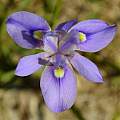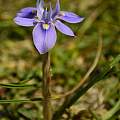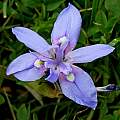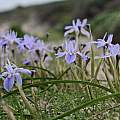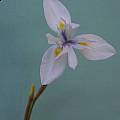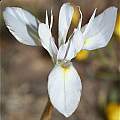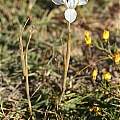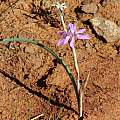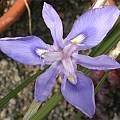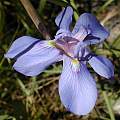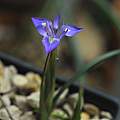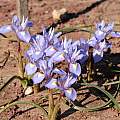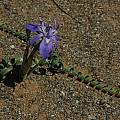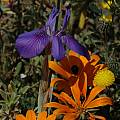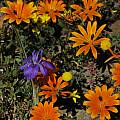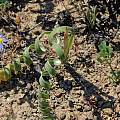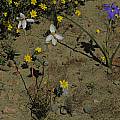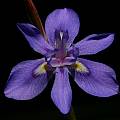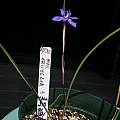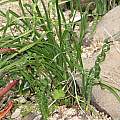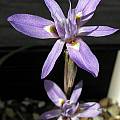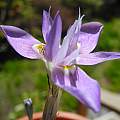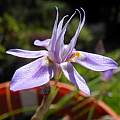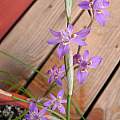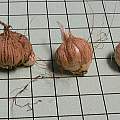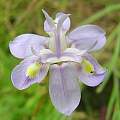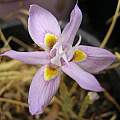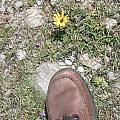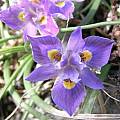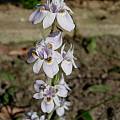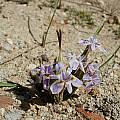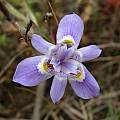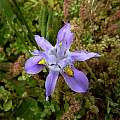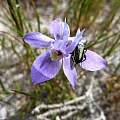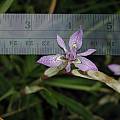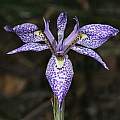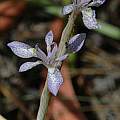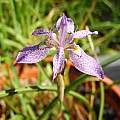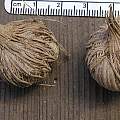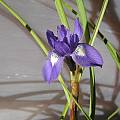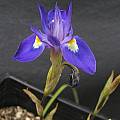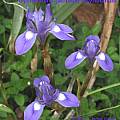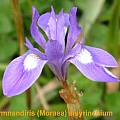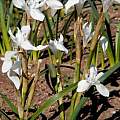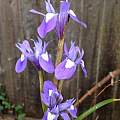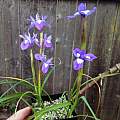The genus Moraea can be divided into five groups: Galaxia, Gynandriris, Hexaglottis , Homeria, and Moraea. Information and pictures can be found by clicking on these groups or the Moraea group pages listed below or found in the Moraea index where all species are listed alphabetically. Gynandriris was formerly considered to be a genus in the Iridaceae family, but is now considered to be a subsection of Moraea. Plants have aerial stems and ovaries that are more or less sessile. There are 2 or 3 species in the Mediterranean region and western to central Asia and 7 more in South Africa. Most of these species root and grow during autumn and winter and flower in spring.
Moraea australis (Goldblatt) Goldblatt, syn. Gynandriris australis Goldblatt, grows in coastal sand dunes and rocky flats in the southeastern Cape, South Africa, and flowers September-November. Growing from 12-25 cm, it has large, pale blue or deep blue flowers with cream nectar guides. Photos from iNaturalist taken by Adriaan Grobler near Port Elizabeth in the Eastern Cape in September and Friends of St Francis Nature Areas in the area they cover in October and shared under a CC BY-NC license.
Moraea cedarmontana (Goldblatt) Goldblatt, syn. Gynandriris cedarmontana Goldblatt, has two trailing leaves and small white flowers with yellow nectar guides. It only opens in late afternoon and many years I have not noticed it until after it has flowered. Other years it doesn't bloom at all. It is found on streambanks in sandy soils in the Northwest Cape, South Africa, and blooms in spring. Height range: 10-30 cm. The first photo was taken by Mary Sue Ittner and the next two in habitat by Andrew Harvie east of Koebeeberge in the Western Cape.
Moraea contorta Goldblatt, syn. Gynandriris anomala Goldblatt, is found on stony clay flats and slopes in the Roggeveld (a colder dry part of South Africa's winter rainfall area). Growing from 20 to 30 cm, it has a single linear leaf and deep blue-violet flowers with white nectar guides. It flowers in spring, September-October. The first two photos were taken by Alan Horstmann in habitat in October. The third photo was taken by Mark Mazer, who grew this species from Silverhill Seeds. The last photo was taken by Dirk Wallace.
Moraea mediterranea Goldblatt, syn. Gynandriris monophylla Klatt, is a tiny species less than 10 cm tall. It has one basal leaf and small pale grey/blue flowers with a large yellow patch on the falls. Distributed in East Crete, North Africa (Egypt and Libya), Palestine, Israel and Jordan, blooming in early March. Flowers open at midday to close after a few hours. Photos taken by Oron Peri in his collection.
Moraea pritzeliana Diels, syn. Gynandriris pritzeliana (Diels) Goldblatt, is a spring blooming species found on sandstone and clay soils, mainly in renosterveld (Bokkeveld Plateau and western Karoo), South Africa. Each bulb produces two leaves that can be coiled and dark blue flowers with cream nectar guides. In September 2006 there were beautiful displays of this species in Calvinia and near Nieuwoudtville. Height range: 30-45 cm. Photos by Bob Rutemoeller and Mary Sue Ittner show it blooming with beetle daisies (Gorteria diffusa) and with Ursinia nana. Leaves are not always coiled in cultivation, nor were they in the wild, but a couple of pictures shows leaves that were coiled. In the last picture shown with Cyanella alba, the leaves are not coiled.
Photos 1-2 of plants in cultivation were taken by Bob Werra. Photo 3 was taken by Nhu Nguyen from the UC Botanical Garden showing the habit of the plant.
Moraea setifolia (L.f.) Druce, syn. Gynandriris setifolia (L.f.) R.C.Foster, has small blue flowers that open in early afternoon and close by late afternoon. It makes up for the short bloom by producing many flowers over a long period and as the time passes, more are produced on the same day. It is found on sandy and gravelly flats and slopes in a wide distribution area including winter rainfall and year round rainfall areas, South Africa. It is easily grown in a container, even a small one that can be taken with you so you can see it in bloom. It is sometimes confused with Moraea elliotii which is another small species in the Moraea group that grows in summer unlike this species which is a winter growing species. Height range: 30-45 cm. The first photo was taken by Bob Rutemoeller and the rest from Mary Sue Ittner, including some showing how many flowers can be in bloom at once as the plants continue to bloom and branch. The last photo shows the corms on a 1 cm grid.
Photosbelow were taken by Dirk Wallace.
The first two photos were taken by Diane Whitehead who found a tiny moraea in grass next to the beach at Cape Agulhas, the southernmost point of Africa, in bloom in mid-September. The flower was fingernail-sized and seems to be this species. There are six plants of it in the picture of the shoe -- all those little purple dots are flowering moraeas.
Photos below were taken by Cameron McMaster. Photos 1-3 were taken in Napier and Bredasdorp in the Overberg and photo 4-5 were taken in the Rocherpan Nature Reserve north of Velddrif on the Cape West Coast.
Moraea simulans Baker, syn. Gynandriris simulans (Baker) R.C.Foster, is native to southern Africa and is supposed to be from a summer rainfall area. Height range: 30-60 cm. But photo 1 shows it blooming late spring-summer in Jana Ulmer's garden in northern California. It grows in winter, but does not flower until late spring. It may need some water in summer. Photo 2 from Andrew Harvie. Photos 3-5 taken by Mary Sue Ittner of flowers and corms. Although she has grown this plant for years, only twice has it bloomed. Each time it was a surprise, as she had not seen signs of it for a number of years.
Moraea sisyrinchium (L.) Ker Gawl., syn. Gynandriris sisyrinchium (L.) Parl., is native to the Mediterranean region and flowers mid to late spring. It is known by the common name Barbary nut and the corm has been used as a food source in the past. The plant pictured below was grown from seed and always flowers much earlier than the one illustrated under it. Flowers don't open unless the day is warm, and often as not, until late afternoon and they do not last very long. But each plant produces a number of flowers. Height range: 10-45 cm. The first photo by Mary Sue Ittner was taken early March 2004 and the second one was taken by Bob Rutemoeller of a form that blooms later in the spring from the little island of Marettimo (offshore Western Sicily). Photos 3 and 4 were supplied by Jamie Vande taken mid-April in his Cologne garden of bulbs obtained from Lauw de Jager. They open around 16:00 in the afternoon and are very short-lived. Last photo of an albino form found by Oron Peri on Mt. Hermon.
The photos below were taken by Uluwehi Knecht.
Galaxia - Hexaglottis - Homeria a-j - Homeria k-z - Moraea group a - Moraea group b - Moraea group c-e - Moraea group f - Moraea group g-i - Moraea group j-m - Moraea group n-r - Moraea group s - Moraea group t - Moraea group u-v - Moraea hybrids - Moraea index
